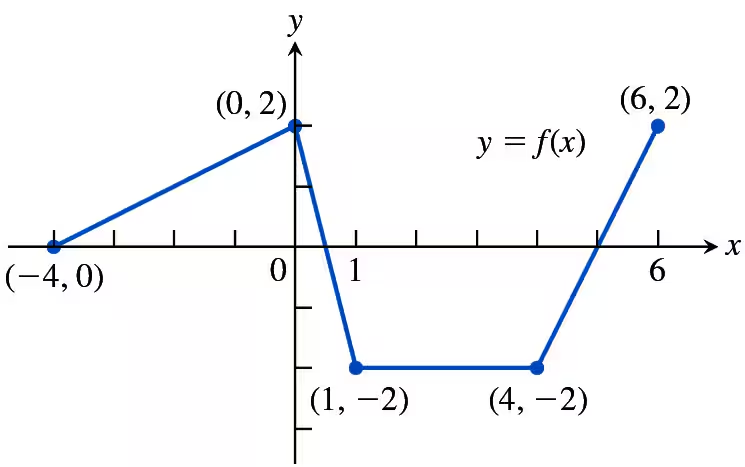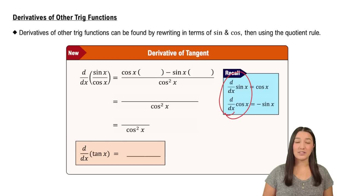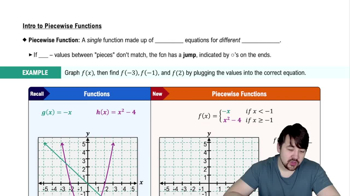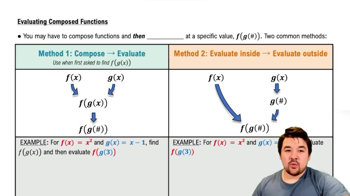For x > 0, what is f′(x)?
Table of contents
- 0. Functions7h 54m
- Introduction to Functions16m
- Piecewise Functions10m
- Properties of Functions9m
- Common Functions1h 8m
- Transformations5m
- Combining Functions27m
- Exponent rules32m
- Exponential Functions28m
- Logarithmic Functions24m
- Properties of Logarithms36m
- Exponential & Logarithmic Equations35m
- Introduction to Trigonometric Functions38m
- Graphs of Trigonometric Functions44m
- Trigonometric Identities47m
- Inverse Trigonometric Functions48m
- 1. Limits and Continuity2h 2m
- 2. Intro to Derivatives1h 33m
- 3. Techniques of Differentiation3h 18m
- 4. Applications of Derivatives2h 38m
- 5. Graphical Applications of Derivatives6h 2m
- 6. Derivatives of Inverse, Exponential, & Logarithmic Functions2h 37m
- 7. Antiderivatives & Indefinite Integrals1h 26m
- 8. Definite Integrals4h 44m
- 9. Graphical Applications of Integrals2h 27m
- 10. Physics Applications of Integrals 3h 16m
- 11. Integrals of Inverse, Exponential, & Logarithmic Functions2h 31m
- 12. Techniques of Integration7h 41m
- 13. Intro to Differential Equations2h 55m
- 14. Sequences & Series5h 36m
- 15. Power Series2h 19m
- 16. Parametric Equations & Polar Coordinates7h 58m
2. Intro to Derivatives
Derivatives as Functions
Problem 3.2.31b
Textbook Question
Consider the function f graphed here. The domain of f is the interval [−4, 6] and its graph is made of line segments joined end to end.

b. Graph the derivative of f. The graph should show a step function.
 Verified step by step guidance
Verified step by step guidance1
Step 1: Analyze the graph of f(x). The function is piecewise linear, composed of line segments joined end to end. The domain is [−4, 6], and the graph has vertices at (−4, 0), (0, 2), (1, −2), (4, −2), and (6, 2).
Step 2: Recall that the derivative of a function represents the slope of the tangent line at any given point. For a piecewise linear function, the derivative is constant within each segment since the slope does not change.
Step 3: Calculate the slope of each segment:
- From (−4, 0) to (0, 2), the slope is \( \frac{2 - 0}{0 - (-4)} = \frac{2}{4} = \frac{1}{2} \).
- From (0, 2) to (1, −2), the slope is \( \frac{-2 - 2}{1 - 0} = \frac{-4}{1} = -4 \).
- From (1, −2) to (4, −2), the slope is \( \frac{-2 - (-2)}{4 - 1} = \frac{0}{3} = 0 \).
- From (4, −2) to (6, 2), the slope is \( \frac{2 - (-2)}{6 - 4} = \frac{4}{2} = 2 \).
Step 4: Represent the derivative as a step function. The derivative is constant within each interval:
- On [−4, 0], the derivative is \( \frac{1}{2} \).
- On [0, 1], the derivative is −4.
- On [1, 4], the derivative is 0.
- On [4, 6], the derivative is 2.
Step 5: Sketch the graph of the derivative. The graph will be a step function with constant values:
- A horizontal line at \( \frac{1}{2} \) from x = −4 to x = 0.
- A horizontal line at −4 from x = 0 to x = 1.
- A horizontal line at 0 from x = 1 to x = 4.
- A horizontal line at 2 from x = 4 to x = 6.
 Verified video answer for a similar problem:
Verified video answer for a similar problem:This video solution was recommended by our tutors as helpful for the problem above
Video duration:
4mPlay a video:
Was this helpful?
Key Concepts
Here are the essential concepts you must grasp in order to answer the question correctly.
Derivative of a Function
The derivative of a function at a point measures the rate at which the function value changes as its input changes. For a piecewise linear function, the derivative is constant on each segment, representing the slope of the line. In this graph, the derivative will be a step function, indicating constant slopes between the given points.
Recommended video:

Derivatives of Other Trig Functions
Piecewise Linear Functions
A piecewise linear function is composed of straight line segments. Each segment has a constant slope, which is the derivative of the function over that interval. Understanding the slopes of these segments is crucial for graphing the derivative, as each segment's slope corresponds to a constant value in the derivative's graph.
Recommended video:

Piecewise Functions
Step Functions
A step function is a piecewise function that jumps from one constant value to another at specific points. When graphing the derivative of a piecewise linear function, the result is a step function, where each step corresponds to the slope of a segment in the original function. This graph will have horizontal lines at the slope values, changing at the endpoints of each segment.
Recommended video:

Evaluating Composed Functions
Related Videos
Related Practice
Textbook Question


